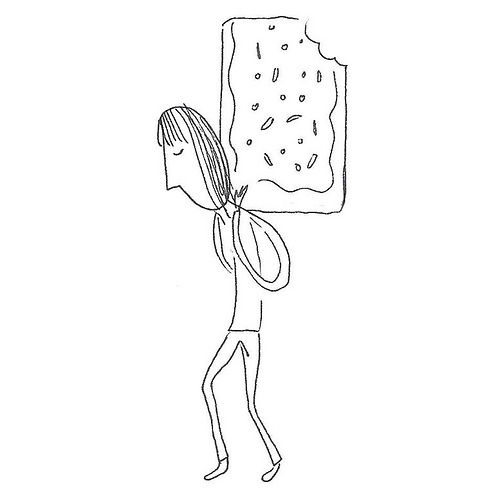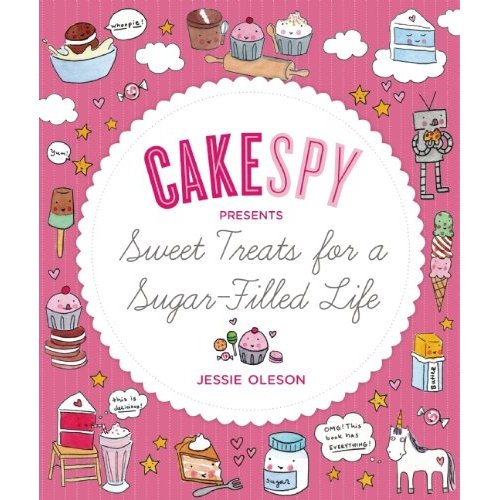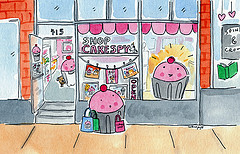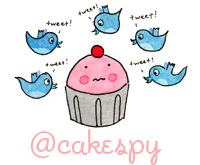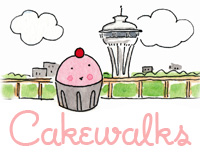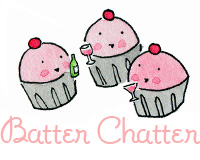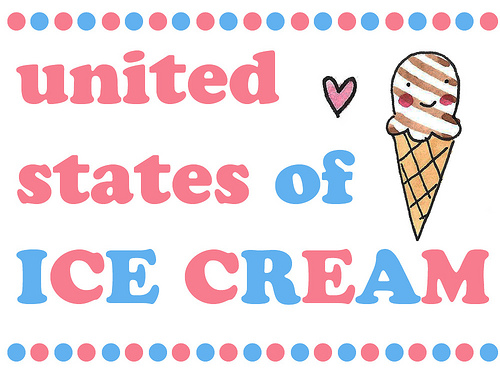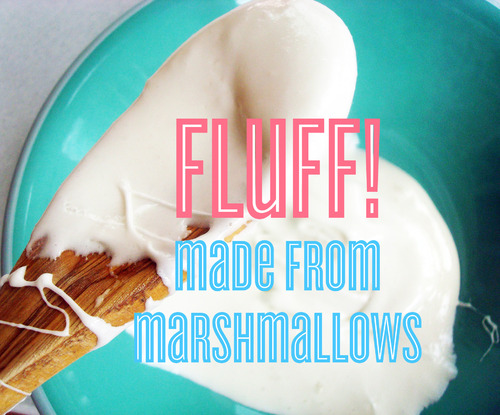Where do brownies come from?
It's a simple question, but seeking out the answer proves slightly more difficult. The stories are many and sometimes seemingly conflicting--and so rather than try to find out which one is "real", I instead offer that perhaps the brownie that we know today is a combination of the following events, listed in a timeline format. Brownie, this is your life.
1780: Bakers Chocolate is invented.
1828: Cocoa powder is invented.
In the late 1800s, a couple of perhaps related, perhaps unrelated, things were happening.
1887 In the world of culture, the term "brownies" first popped up as a series of cartoon characters in a book series by Palmer Cox. These cartoon characters are sort of do-good elves who work at night; as to why they were called Brownies, there are a few theories, ranging from a reference to their skin and hair color to a legend that they were led by a hunchback named Brown. Read more in an 1892 article from the Ladies Home Journal.
1893: “This dessert was created in the kitchen of the Palmer House Hotel during the 1893 Columbian Exposition when Mrs. Bertha Palmer requested the chef make a “ladies dessert” that would be easier to eat than a piece of pie, and smaller serving than a slice of layer cake, which could be used in box lunches at the Women’s Building at the Fair.” “This recipe is still served today at the Palmer House Hilton on State Street and is one of their most popular confections.”- From Epicurious.com
1896: A recipe entitled "Brownies" is published in the Boston Cooking scool--for molasses blondie-type confections in individual molds. They'd be closer to what we today call Blondies. Here's that recipe:
Boston Cooking School Cook Book (1896), page 424
Boston, Massachusetts
Brownies
1/3 cup butter
1/3 cup powdered sugar
1/3 cup Porto Rico molasses
1 egg, well beaten
7/8 cup flour
1 cup pecan meats cut in piecesBake in small, shallow fancy cake tins, garnishing top of each cake with one-half pecan
1897: A recipe for "Brownies" appears in a Sears Roebuck catalog. These are closer to the Boston Cooking school version.
1900: The Brownie camera debuts--rumor has it, it was capitalizing on the brownie character from the Palmer Cox books, and that the writer never saw a penny from it.
1901: "Chocolate Brownies" are sold as candies; various newspapers have ads for them during or around 1901.
1905: In the book Home Cook Book, Practical Recipes by Expert Cooks, this recipe appears:
Brownies (cookies)
¼ lb. [½ cup] butter
¼ lb. [½ cup] granulated sugar
2 eggs
Grated Rind of a Lemon
4 oz. [4 squares] grated chocolate
½ cup milk
pinch of salt
1 lb [3 cups] flour
“Stir briskly together, roll out and cut in brownie or other shapes …”
1906: A new chocolate version of "Brownies" shows up in the new edition of the Boston Cooking School book. This recipe is believed to be the first for a chocolate brownie in a cookbook. I found this recipe in an article in the Chicago Tribune, which notes that "It makes a lower, denser treat than today's thicker, cakelike brownies."
1906 Brownies
Ingredients:
1 cup sugar
1/4 cup melted butter
1 egg, unbeaten
2 squares Baker's chocolate, melted
3/4 teaspoon vanilla
1/2 cup flour
1/2 cup walnut meats, cut in pieces
Mix ingredients in order given. Line a seven-inch square pan with paraffine paper. Spread mixture evenly in pan and bake in slow oven. As soon as taken from oven turn from pan, remove paper, and cut cake in strips, using a sharp knife. If these directions are not followed, paper will cling to cake, and it will be impossible to cut it in shapely pieces.
1907: The Lowney's Brownie debuts. It was the creation of Maria Willett Howard, who had been trained by Fannie Farmer, and was then employed by the Walter Lowney chocolate company, who adapted the 1906 recipe with an extra egg, creating Lowney's Brownies. According to The Food Timeline, "She then varied the recipe by adding an extra square of chocolate and named the Bangor Brownies. This last recipe apparently started the idea that brownies were invented by housewives in Bangor, Maine."
1908: Duncan Hines is born: this won't affect the brownie just yet, but it will one day.
1912: The Bangor theory is also based on the evidence that there is a recipe for brownies in a 1912 publication,Girl's Welfare Cook Book, but this is several years after Farmer's recipe, making it unlikely that the Bangor version preceded hers.
1915: Brownies (the division of the girl scouts) are invented--originally called Rosebuds.
1916: "Brownies" is first trademarked as a foodstuff by the National Biscuit Company. The trademark on the term "brownies" has since expired and it is
1924: Palmer Cox, creator of the "Brownies" tales, dies.
1929: William Dreyer invents Rocky Road Ice Cream--how long did it take for someone to translate this killer combo into brownie form?
1933: Brownies and brownies come together:
Duncan Hines, yet to enter the brownie and cake mix world, has a suspiciously brownielike recipe in Adventures in Good Cooking and the Art of Carving in the Home: Tested Recipes of Unusual Dishes from America's Favorite Eating Places. Sample here: 520. Fudge Squares. Ingredients 1/2 cup butter 2 oz. bitter chocolate or 1/3 cup cocoa plus 1 tablespoon butter...Melt Butter and chocolate 1/2 cup cake flour 1 1/4 cups sugar 1/8 teaspoon salt...Sift twice and add to above 3 eggs--beaten 1 teaspoon vanilla 3/4 cup chopped nuts (walnuts or pecans)...Stir into mixture and bake in 350 F. to 375 F. oven for 25 minutes. ---Duncan Hines, Bowling Green Kentucky, Adventures in Good Cooking and the Art of Carving in the Home, Duncan Hines, recipes from the original 1933 edition edited by Louis Hatchett [Mercer University Press:Macon, GA] 2002 (unpaginated).
1941: A New York Times article describes how in New England, brownies are all the rage.
1954: The first ever brownie mix is patented.
1965: Craig Claiborne rights the perception the brownies are only chocolate, in a love letter to the Blondie.
1970s: According to the New York Times,
The 1970s marked the beginning of the chocolate cult; the term “chocoholic” came into vogue, and the “Cathy” comic strip picked up the thread in the 1980s with endless jokes about chocolate cravings, feeding the image of women — especially lonely single women — with a weakness for the stuff.
1975: Katharine Hepburn Brownies
1988: Brownie Cones are trademarked. I couldn't find the official one, but here's a recipe for brownie cones that makes me happy.
1991: Fat Witch Brownies is founded in New York City, specializing in a particularly dense, fudgelike brownie.
1998: Nick Malgieri releases his recipe for "Supernatural Brownies" to the public in his book
Chocolate: From Simple Cookies to Extravagant Showstoppers
1999: Alice Medrich releases her recipe for "New Classic Brownies" in her book
The Brownie Diet is a Thing.
2000: Brownie Cream Cheese pie takes the cake at the Pillsbury Bake Off
2002: A 3,000 pound brownie.
2005: Moveable Feast's Fudgy Brownies are cited as one of Oprah's "favorite things"
2007: The most expensive brownie in the world can be found at Brulee at this time? $750.
2009: The Original Brownie Whoopie pie is trademarked.
2010: Mary J's Relaxation Brownies, featuring melatonin, debut. Valley of the Dolls Brownies?
Also this year, Cocoa Puffs Brownie Crunch debuts.
Also this year, Brownie Husband makes brownies sexy and gross and funny.
 Thursday, May 28, 2015
Thursday, May 28, 2015 









